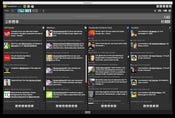IBM Connects With Social SoftwareIBM Connects With Social Software
Jeff Schick, IBM's vice president of social software, gives a tour of the company's various social media applications and how he uses activity streams and communities throughout the day.


Top 20 Apps For Managing Social Media
(click image for larger view)
Top 20 Apps For Managing Social Media
You might expect IBM to "eat its own dog food," as the software industry saying goes, by using the enterprise social software it promotes to maximum effect internally. You would be right, except that IBM's VP of social software Jeff Schick prefers to put it a bit differently.
"We drink our own champagne" is the way he prefers to say it. As part of an interview this week, Schick gave a chef's tour via Web conference of the portal he signs on to every morning, the IBM activity stream he monitors, and the range of tools he has at his fingertips that blend aspects of social media, unified communications, and all that stuff we used to call groupware.
Schick acknowledges many aspects of the new social software from IBM are simply the latest incarnations of technologies the company has had under development for years, particularly in the Lotus division that gave us Notes and Sametime. Still, he sees a generational change in these technologies driven by the more social nature of today's Web.
"From my perspective, and our experience working with clients in market, there is something subtly different," he said. "It used to be hard to publish to the Web." Collaborative environments and team workspaces have been around for years, but the content management systems and mechanisms for checking documents in and out of repositories tended to be a bit clumsy, he said. "What fundamentally happened here, in the shift to Web 2.0, is it became easy to publish content, to self-generate content, and to share it."
Executives who sign onto Facebook to keep up with their kids, friends, and families are coming into work and asking, "Why can't it be that easy?" In other words, why can't it be that easy to share information across the company and keep up with what the other people I work with are doing?
So naturally IBM has been thinking about giving users a sense of familiarity, in terms of mimicking some of the user interface metaphors found on sites like Facebook, Schick said. "I also think it's important to break down some of the silos of collaboration, which is what an activity stream gives you."
On the other hand, a corporate collaboration system can't be quite as freewheeling as Facebook, Schick said. "While the idea starts with I want something super simple to use, the next thought coming from those C-level executives is about how to ensure compliance and keep control." They also want to make sure that the social network is not just social for its own sake, but productive for getting work done.
IBM's social media software Lotus Connections (soon to be rebranded IBM Connections) addresses these requirements with a mix of ad hoc, personalized, and structured collaboration tools.

Inside Watson, IBM's Jeopardy Computer
(click image for larger view)
Slideshow: Inside Watson, IBM's Jeopardy Computer
When Schick signs on each morning, he checks the activity stream of notes from his contacts and adds his own update on his plans for the day. Sometimes, that simple action can be surprisingly productive, he said. For example, when IBM salespeople see that he will be traveling to their area, they often rope him in on a meeting with a hot prospect. "I've closed deals, some of them multi-million dollar opportunities, that I might not have had the chance to get involved in otherwise," he said.
Everywhere within the portal that an employee is represented as the author of a document or a note, Schick can get a pop-up "business card" profile by hovering his mouse over the name or photo. Emailing, instant messaging, calling, or setting up a video call are just a couple of clicks away. Through integration with IBM's human resources systems, he can also see where the contact is in the organizational hierarchy, including reporting relationships. Those contacts are also available through a searchable directory, and IBM processes about 6 million lookups every day from employees trying to find and contact each other, Schick said.
Schick uses the Connections home page to get an overview of everything he needs to know to start his day, but he also maintains a separate information dashboard he has customized to show the news and activities he needs to track most closely.
For more structured work, Connections offers an Activities tab. For example, all the planning for the recent Lotusphere conference was plotted out as an activity with sub-tasks for the opening ceremony, the media plan for the event, and so on, and each of those tasks could have other documents, notes, questions, and answers attached to it. After running a successful event, the team behind it can then take the structure of that activity and turn it into a template so next year's event planners will have a thorough outline of all the tasks to be completed.
Another way IBM organizes its collaboration is through communities -- more than 23,000 of them "for every science we do, every industry we serve, every product we build," Schick said.
Again, the idea of forming communities of interest within an organization is a concept with roots in many early groupware, collaboration, and knowledge management efforts, but the proliferation and usage of these communities has exploded with the latest generation of technologies. "Now, I think the growth we're seeing in communities both large and small is that this is so darn easy," Schick said.
At the same time it supports ad hoc creation of communities and tagging of content, IBM does have an administrative team that tries to keep it under control. The tagging system was seeded in the first place with established taxonomies IBM had developed, and community managers do police the overall organization of the environment.
However, keeping everything tidy isn't the most important thing, Schick said. "The secret ingredient to having a successful community is that it's vibrant, and that it's the place to go on a particular topic."
About the Author
You May Also Like






